TensorFlow
Course 1 and Course 2
【吴恩达团队Tensorflow2.0实践系列课程第一课】TensorFlow2.0中基于TensorFlow2.0的人工智能、机器学习和深度学习简介及基础编程
【吴恩达团队Tensorflow2.0实践系列课程第二课】卷积神经网络在TensorFlow2.0中的应用_哔哩哔哩_bilibili
1. Download files with Python
from requests import get
from time import time
from math import floor
from tqdm import tqdm
url = '...'
file_name = '...'
with get(url, stream=True) as r:
print("正在检查资源大小")
b = int(r.headers.get('Content-Length')) / 1024 / 1024
print("资源大小:", b, "MB")
print('-' * 32)
chunk_size = 1048
print("正在下载")
a = time()
with open('./tmp/' + file_name, "wb") as code:
for chunk in tqdm(r.iter_content(chunk_size=chunk_size)):
code.write(chunk)
code.flush()
code.close()
'''
with open('./tmp/' + file_name, "wb") as f:
f.write(r.content)
f.flush()
f.close()
'''
a = time() - a
if a :
print("平均写入速度:约", floor((b / a) * 100) / 100, "MB/s")
else:
print("平均写入速度:约 0 MB/s")
print('-' * 32)
2. Unzip the zip file with Python
import zipfile
local_zip = './tmp/horse-or-human.zip'
zip_ref = zipfile.ZipFile(local_zip, 'r')
zip_ref.extractall('./tmp/horse-or-human')
local_zip = './tmp/validation-horse-or-human.zip'
zip_ref = zipfile.ZipFile(local_zip, 'r')
zip_ref.extractall('./tmp/validation-horse-or-human')
zip_ref.close()
3. Show data sample images
import matplotlib.pyplot as plt
import matplotlib.image as mpimg
nrows = 4
ncols = 4
pic_index = 0
fig = plt.gcf()
fig.set_size_inches(ncols * 4, nrows * 4)
pic_index += 8
next_horse_pix = [os.path.join(train_horse_dir, fname)
for fname in train_horse_names[pic_index - 8:pic_index]]
next_human_pix = [os.path.join(train_human_dir, fname)
for fname in train_human_names[pic_index - 8:pic_index]]
for i, img_path in enumerate(next_horse_pix + next_human_pix):
sp = plt.subplot(nrows, ncols, i + 1)
sp.axis('Off')
img = mpimg.imread(img_path)
plt.imshow(img)
plt.show()
4. ImageDataGenerator and Image augmentation
参数解释:
rotation_rangeis a value in degrees (0–180), a range within which to randomly rotate pictures.width_shiftandheight_shiftare ranges (as a fraction of total width or height) within which to randomly translate pictures vertically or horizontally.shear_rangeis for randomly applying shearing transformations.zoom_rangeis for randomly zooming inside pictures.horizontal_flipis for randomly flipping half of the images horizontally. This is relevant when there are no assumptions of horizontal assymmetry (e.g. real-world pictures).vertical_flipfill_modeis the strategy used for filling in newly created pixels, which can appear after a rotation or a width/height shift.validation_split=0.2andsubset='validation'
from keras.preprocessing.image import ImageDataGenerator
train_datagen = ImageDataGenerator(
rescale=1/255,
rotation_range=40,
width_shift_range=0.2,
height_shift_range=0.2,
shear_range=0.2,
zoom_range=0.2,
horizontal_flip=True,
fill_mode='nearest'
)
validation_datagen = ImageDataGenerator(rescale=1/255)
train_generator = train_datagen.flow_from_directory(
'./tmp/horse-or-human/',
target_size=(300, 300),
batch_size=32,
class_mode='binary'
)
validation_generator = validation_datagen.flow_from_directory(
'./tmp/validation-horse-or-human/',
target_size=(300, 300),
batch_size=32,
class_mode='binary'
)
5. Building and running the model
import tensorflow as tf
model = tf.keras.models.Sequential([
tf.keras.layers.Conv2D(16, (3, 3), activation='relu', input_shape=(300, 300, 3)),
tf.keras.layers.MaxPooling2D(2, 2),
tf.keras.layers.Conv2D(32, (3, 3), activation='relu'),
tf.keras.layers.MaxPooling2D(2, 2),
tf.keras.layers.Conv2D(64, (3, 3), activation='relu'),
tf.keras.layers.MaxPooling2D(2, 2),
tf.keras.layers.Conv2D(64, (3, 3), activation='relu'),
tf.keras.layers.MaxPooling2D(2, 2),
tf.keras.layers.Conv2D(64, (3, 3), activation='relu'),
tf.keras.layers.MaxPooling2D(2, 2),
tf.keras.layers.Flatten(),
tf.keras.layers.Dropout(0.5),
tf.keras.layers.Dense(512, activation='relu'),
tf.keras.layers.Dense(1, activation='sigmoid')
])
model.summary()
model.compile(loss='binary_crossentropy',
optimizer=tf.keras.optimizers.RMSprop(0.001),
metrics=['acc'])
history = model.fit(
train_generator,
steps_per_epoch=32,
epochs=15,
verbose=1,
validation_data=validation_generator,
validation_steps=8
)
6. Evaluating the model
import matplotlib.pyplot as plt
acc = history.history['acc']
val_acc = history.history['val_acc']
loss = history.history['loss']
val_loss = history.history['val_loss']
epochs = range(len(acc))
plt.figure()
plt.plot(epochs, acc, 'bo', label='Training accuracy')
plt.plot(epochs, val_acc, 'b', label='Validation accuracy')
plt.title('Training and validation accuracy')
plt.figure()
plt.plot(epochs, loss, 'bo', label='Training Loss')
plt.plot(epochs, val_loss, 'b', label='Validation Loss')
plt.title("Training and validation loss")
plt.legend()
plt.show()
7. Predicting
import numpy as np
from keras.utils import image_utils
from tkinter.filedialog import askopenfilename
path_img = askopenfilename()
img = image_utils.load_img(path_img, target_size=(300, 300))
x = image_utils.img_to_array(img)
x = np.expand_dims(x, axis=0)
print(x.shape)
images = np.vstack([x])
print(images.shape)
classes = model.predict(images, batch_size=10)
print(classes)
if classes[0] > 0.5:
print("It is a human")
else:
print("It is a horse")
import numpy as np
import os
from keras.preprocessing.image import load_img, img_to_array
test_dir = './test1/'
test_id = os.listdir(test_dir)
alls = []
for f in test_id:
image = load_img(os.path.join(test_dir, f), target_size=(150, 150))
x = img_to_array(image)
x = np.expand_dims(x, axis=0)
alls.append(x)
images = np.vstack(alls)
print(images.shape)
predictions = model.predict(images).flatten().astype(int)
8. Visualizing intermediate representations
import numpy as np
import random
from keras.utils.image_utils import load_img, img_to_array
successive_outputs = [layer.output for layer in model.layers[1:]]
visualization_model = tf.keras.models.Model(inputs=model.input, outputs=successive_outputs)
horse_img_files = [os.path.join(train_horse_dir, f) for f in train_horse_names]
human_img_files = [os.path.join(train_human_dir, f) for f in train_human_names]
img_path = random.choice(horse_img_files + human_img_files)
img = load_img(img_path, target_size=(300, 300))
x = img_to_array(img)
x = x.reshape((1, ) + x.shape)
x /= 255
successive_feature_maps = visualization_model.predict(x)
layer_names = [layer.name for layer in model.layers]
for layer_name, feature_map in zip(layer_names, successive_feature_maps):
if len(feature_map.shape) == 4:
n_features = feature_map.shape[-1]
size = feature_map.shape[1]
display_grid = np.zeros((size, size * n_features))
for i in range(n_features):
x = feature_map[0, :, :, i]
x -= x.mean()
x /= x.std()
x *= 64
x += 128
x = np.clip(x, 0, 255).astype('uint8')
display_grid[:, i * size : (i + 1) * size] = x
scale = 20. / n_features
plt.figure(figsize=(scale * n_features, scale))
plt.title(layer_name)
plt.grid(False)
plt.imshow(display_grid, aspect='auto', cmap='viridis')
layer_outputs = [layer.output for layer in model.layers]
activation_model = tf.keras.models.Model(inputs=model.input, outputs=layer_outputs)
print(test_labels[:100])
for x in range(0, 4):
f1 = activation_model.predict(test_images[FIRST_IMAGE].reshape(1, 28, 28, 1))[x]
axarr[0, x].imshow(f1[0, :, :, CONVOLUTION_NUMBER], cmap='inferno')
axarr[0, x].grid(False)
f2 = activation_model.predict(test_images[SECOND_IMAGE].reshape(1, 28, 28, 1))[x]
axarr[1, x].imshow(f2[0, :, :, CONVOLUTION_NUMBER], cmap='inferno')
axarr[1, x].grid(False)
f3 = activation_model.predict(test_images[THIRD_IMAGE].reshape(1, 28, 28, 1))[x]
axarr[2, x].imshow(f3[0, :, :, CONVOLUTION_NUMBER], cmap='inferno')
axarr[2, x].grid(False)
plt.show()
9. Callbacks
import tensorflow as tf
class myCallback(tf.keras.callbacks.Callback):
def on_epoch_end(self, epoch, log={}):
if log.get('accuracy') > 0.998:
print("\nReached 99.8% accuracy so cancelling training!")
self.model.stop_training = True
mnist = tf.keras.datasets.mnist
(x_train, y_train), (x_test, y_test) = mnist.load_data()
x_train = x_train.reshape(-1, 28, 28, 1)
x_test = x_test.reshape(-1, 28, 28, 1)
x_train = x_train / 255.0
x_test = x_test / 255.0
callbacks = myCallback()
model = tf.keras.models.Sequential([
tf.keras.layers.Conv2D(64, (3, 3), activation='relu', input_shape=(28, 28, 1)),
tf.keras.layers.MaxPooling2D(2, 2),
tf.keras.layers.Flatten(),
tf.keras.layers.Dense(512, activation='relu'),
tf.keras.layers.Dense(10, activation='softmax')
])
model.compile(optimizer='adam',
loss='sparse_categorical_crossentropy',
metrics=['accuracy'])
model.fit(x_train, y_train, epochs=20, callbacks=[callbacks])
model.evaluate(x_test, y_test)
10. Transfer learning
from keras import layers, Model
from keras.applications.inception_v3 import InceptionV3
from keras.optimizers import RMSprop
local_weights_file = './tmp/inception_v3_weights_tf_dim_ordering_tf_kernels_notop.h5'
pre_trained_model = InceptionV3(input_shape=(150, 150, 3),
include_top=False,
weights=None)
pre_trained_model.load_weights(local_weights_file)
for layer in pre_trained_model.layers:
layer.trainable = False
pre_trained_model.summary()
last_layer = pre_trained_model.get_layer('mixed7')
print('last layer output shape:', last_layer.output_shape)
last_output = last_layer.output
x = layers.Flatten()(last_output)
x = layers.Dense(1024, activation='relu')(x)
x = layers.Dropout(0.2)(x)
x = layers.Dense(1, activation='sigmoid')(x)
model = Model(pre_trained_model.input, x)
model.compile(optimizer=RMSprop(0.0001),
loss='binary_crossentropy',
metrics=['acc'])
Some models:
- VGG16
- InceptionV3
Course 3: Natural Language Processing in TensorFlow
【吴恩达团队Tensorflow2.0实践系列课程第三课】TensorFlow2.0中的自然语言处理
0. Dateset(json and tfds)
import json
with open('./tmp/sarcasm.json', 'r') as f:
datastore = json.load(f)
sentences = []
labels = []
urls = []
for item in datastore:
sentences.append(item['headline'])
labels.append(item['is_sarcastic'])
urls.append(item['article_link'])
'''
name: 表示数据集的名字
split: 表示数据集的分隔方式
data_dir: 表示读写数据集的目录
batch_size: 指定数据集中每一条数据的大小,默认为1。
shuffle_files: 表示是否打乱输入的数据
download:表示是否将数据集下载到本地,默认为True,如果设置为False,相当于在三个步骤中少了builder.download_and_prepare()这一步。
as_supervised: 为True表示数据集的每一条数据保存为监督学习的方式–2元组(input, label),如果为False表示数据集的每一条数据保存为字典类型{feature1:input, feature:label}。
with_info:如果为True,表示返回的数据集为一个元组 (tf.data.Dataset, tfds.core.DatasetInfo);如果为False,则返回为一个tf.data.Dataset对象。
'''
import tensorflow_datasets as tfds
imdb, info = tfds.load("imdb_reviews/subwords8k", data_dir='./tmp/', with_info=True, as_supervised=True)
1. Tokenizer
import tensorflow as tf
from keras.preprocessing.text import Tokenizer
from keras_preprocessing.sequence import pad_sequences
vocab_size = 10000
embedding_dim = 16
max_length = 100
trunc_type = 'post'
padding_type = 'post'
oov_tok = '<OOV>'
training_size = 20000
tokenizer = Tokenizer(num_words=vocab_size, oov_token=oov_tok)
tokenizer.fit_on_texts(training_sentence)
word_index = tokenizer.word_index
index_word = tokenizer.index_word
training_sequences = tokenizer.texts_to_sequences(training_sentence)
training_padded = pad_sequences(training_sequences,
maxlen=max_length,
padding=padding_type,
truncating=trunc_type)
test_sequences = tokenizer.texts_to_sequences(test_sentence)
test_padded = pad_sequences(test_sequences,
maxlen=max_length,
padding=padding_type,
truncating=trunc_type)
2. Embedding
# 第二层用Flatten效果更好,但耗时更长
model = tf.keras.Sequential([
tf.keras.layers.Embedding(vocab_size, embedding_dim, input_length=max_length),
tf.keras.layers.GlobalMaxPool1D(),
tf.keras.layers.Dense(24, activation='relu'),
tf.keras.layers.Dense(1, activation='sigmoid')
])
3. Decode
def decode_sentence(text):
return ' '.join([index_word.get(i, '?') for i in text])
4. Word to Vector
Embedding projector - visualization of high-dimensional data (tensorflow.org)
import io
out_v = io.open('./tmp/vecs_1.tsv', 'w', encoding='utf-8')
out_m = io.open('./tmp/meta_1.tsv', 'w', encoding='utf-8')
for word_num in range(1, vocab_size):
word = index_word[word_num]
embeddings = weights[word_num]
out_m.write(word + '\n')
out_v.write('\t'.join([str(x) for x in embeddings]) + '\n')
out_m.close()
out_v.close()
5. RNN
model = tf.keras.Sequential([
tf.keras.layers.Embedding(tokenizer.vocab_size, 64),
tf.keras.layers.Bidirectional(tf.keras.layers.LSTM(64)),
tf.keras.layers.Dense(64, activation='relu'),
tf.keras.layers.Dense(1, activation='sigmoid')
])
model2 = tf.keras.Sequential([
tf.keras.layers.Embedding(tokenizer.vocab_size, 64),
tf.keras.layers.Bidirectional(tf.keras.layers.LSTM(64, return_sequences=True)),
tf.keras.layers.Bidirectional(tf.keras.layers.LSTM(32)),
tf.keras.layers.Dense(64, activation='relu'),
tf.keras.layers.Dense(1, activation='sigmoid')
])
model3 = tf.keras.Sequential([
tf.keras.layers.Embedding(tokenizer.vocab_size, 64),
tf.keras.layers.Bidirectional(tf.keras.layers.GRU(32)),
tf.keras.layers.Dense(6, activation='relu'),
tf.keras.layers.Dense(1, activation='sigmoid')
])
# CNN
model4 = tf.keras.Sequential([
tf.keras.layers.Embedding(tokenizer.vocab_size, 64),
tf.keras.layers.Conv1D(128, 5, activation='relu'),
tf.keras.layers.GlobalAveragePooling1D(),
tf.keras.layers.Dense(62, activation='relu'),
tf.keras.layers.Dense(1, activation='sigmoid')
])
6. Generate text
# 生成语料库
tokenizer = Tokenizer()
data = "In the town of Athy one Jeremy Lanigan \n Battered away til he hadnt a pound. \nHis father died and made him a man again \n ..."
corpus = data.lower().split('\n')
tokenizer.fit_on_texts(corpus)
total_words = len(tokenizer.word_index) + 1
# 生成特征与标签
input_sequences = []
for line in corpus:
token_list = tokenizer.texts_to_sequences([line])[0]
for i in range(1, len(token_list)):
n_gram_sequence = token_list[:i+1]
input_sequences.append(n_gram_sequence)
max_sequence_len = max([len(x) for x in input_sequences])
input_sequences = pad_sequences(input_sequences, maxlen=max_sequence_len, padding='pre')
# input_sequences = np.array(input_sequences)
print(type(input_sequences))
xs, labels = input_sequences[:, :-1], input_sequences[:, -1]
ys = tf.keras.utils.to_categorical(labels, num_classes=total_words)
# build and train the model
model = Sequential()
model.add(Embedding(total_words, 64, input_length=max_sequence_len-1))
model.add(Bidirectional(LSTM(20)))
model.add(Dense(total_words, activation='softmax'))
model.compile(loss='categorical_crossentropy', optimizer='adam', metrics=['accuracy'])
model.summary()
history = model.fit(xs, ys, epochs=500, verbose=1)
# generate text
seed_text = "Laurence went to dublin"
next_words = 100
for _ in range(next_words):
token_list = tokenizer.texts_to_sequences([seed_text])[0]
token_list = pad_sequences([token_list], maxlen=max_sequence_len-1, padding='pre')
predict = model.predict(token_list, verbose=0)
predict = predict.argmax()
seed_text += ' ' + tokenizer.index_word[predict]
print(seed_text)
Course 4: Sequences, Time Series and Prediction
【吴恩达团队Tensorflow2.0实践系列课程第四课】序列、时间序列和预测_哔哩哔哩_bilibili
1. Create some time series
a. Trend
# trend
def trend(time, slope=0):
return slope * time
time = np.arange(4 * 365 + 1)
series = trend(time, 0.1)
plot_series(time, series)
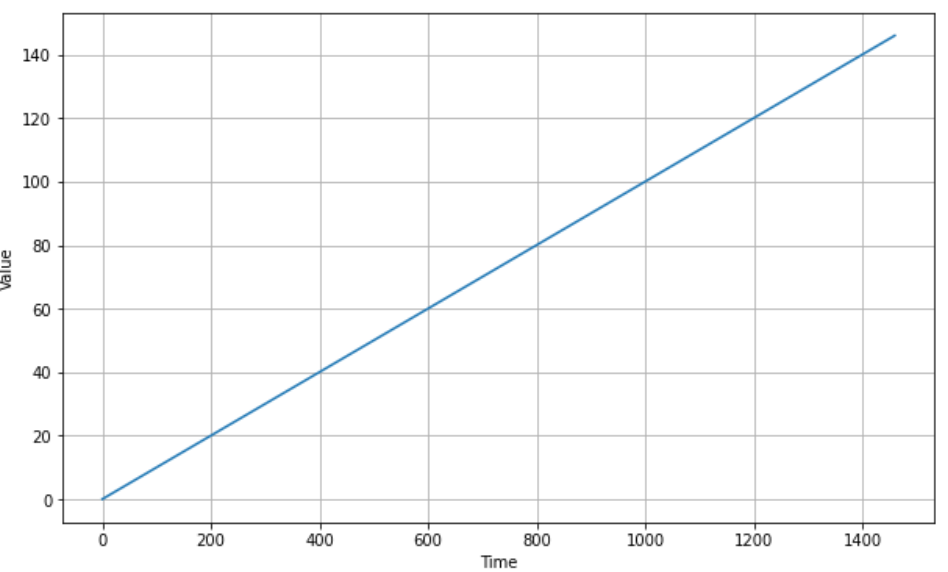
b. Seasonality
# seasonality
def seasonal_pattern(season_time):
return np.where(season_time < 0.4,
np.cos(season_time * 2 * np.pi),
1 / np.exp(3 * season_time))
def seasonality(time, period, amplitude=1, phase=0):
season_time = ((time + phase) % period) / period
return amplitude * seasonal_pattern(season_time)
amplitude = 40
series = seasonality(time, period=365, amplitude=amplitude)
plot_series(time, series)

c. Trend and Seasonality
# trend + seasonality
baseline = 10
slope = 0.05
series = baseline + trend(time, slope) + seasonality(time, period=365, amplitude=amplitude)
plot_series(time, series)
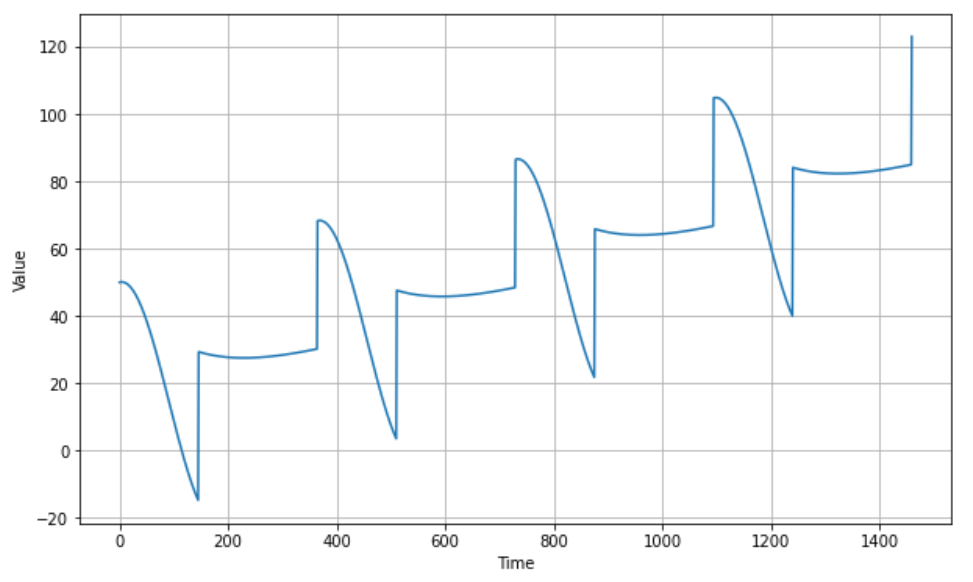
d. White Noise
# white noise
def white_noise(time, noise_level=1, seed=None):
rnd = np.random.RandomState(seed)
return rnd.randn(len(time)) * noise_level
noise_level = 5
noise = white_noise(time, noise_level, seed=42)
plot_series(time, noise)
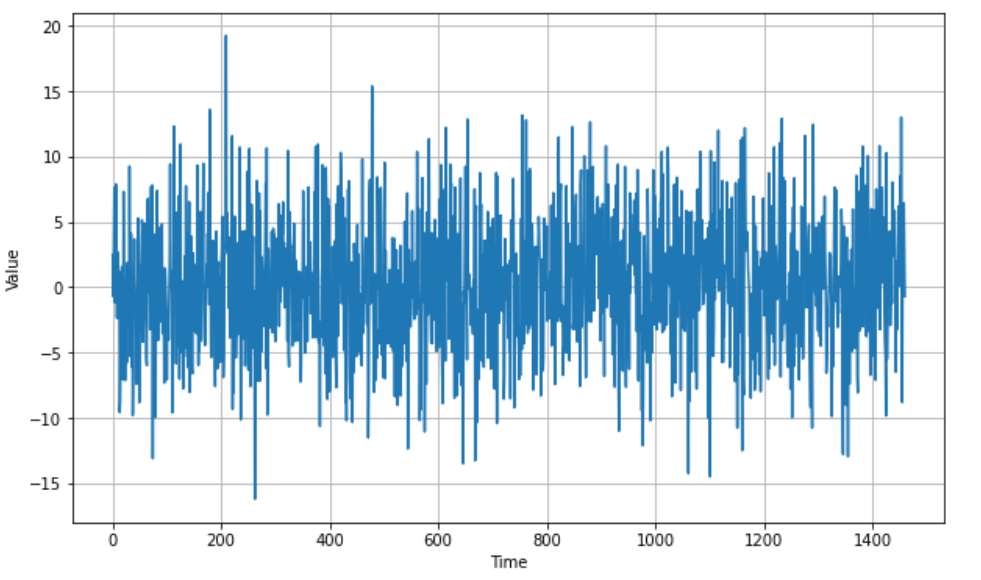
e. Autocorrelation
# autocorrelation
def autocorrelation(time, amplitude, seed=None):
rnd = np.random.RandomState(seed)
φ1 = 0.5
φ2 = -0.1
ar = rnd.randn(len(time) + 50)
ar[:50] = 100
for step in range(50, len(time) + 50):
ar[step] += φ1 * ar[step - 50]
ar[step] += φ2 * ar[step - 33]
return ar[50:] * amplitude
def autocorrelation(time, amplitude, seed=None):
rnd = np.random.RandomState(seed)
φ = 0.8
ar = rnd.randn(len(time) + 1)
for step in range(1, len(time) + 1):
ar[step] += φ * ar[step - 1]
return ar[1:] * amplitude
series = autocorrelation(time, amplitude, seed=42)
plot_series(time[:200], series[:200])

f. Autocorrelation and Trend
# autocorrelation + trend
series = autocorrelation(time, 10, seed=42) + trend(time, 2)
plot_series(time[:200], series[:200])
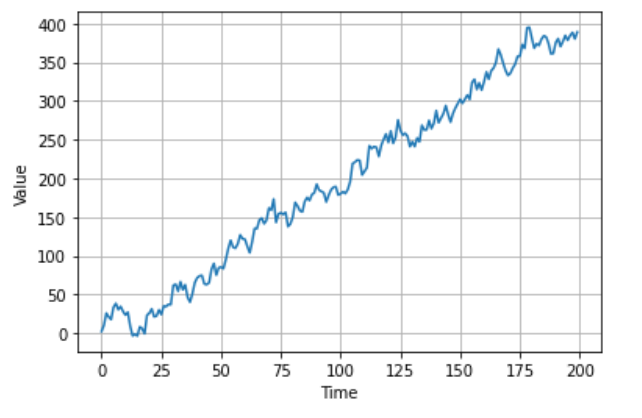
g. Autocorrelation and Seasonality
# autocorrelation + seasonality
series = autocorrelation(time, 10, seed=42) + seasonality(time, period=50, amplitude=150) + trend(time, 2)
plot_series(time[:200], series[:200])
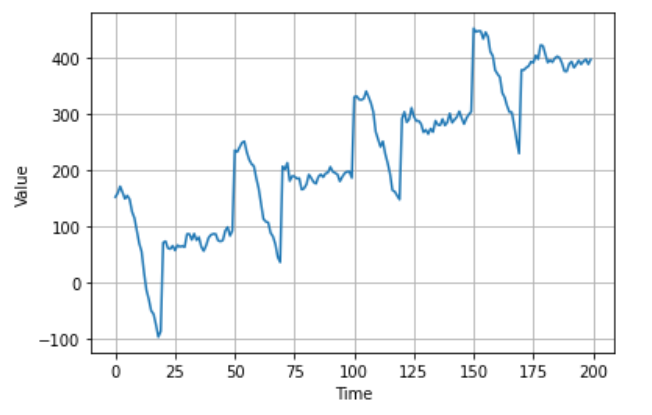
h. Autocorrelation and Autocorrelation
# autocorrelation + autocorrelation
series = autocorrelation(time, 10, seed=42) + seasonality(time, period=50, amplitude=150) + trend(time, 2)
series2 = autocorrelation(time, 5, seed=42) + seasonality(time, period=50, amplitude=2) + trend(time, -1) + 550
series[200:] = series2[200:]
#series += noise(time, 30)
plot_series(time[:300], series[:300])
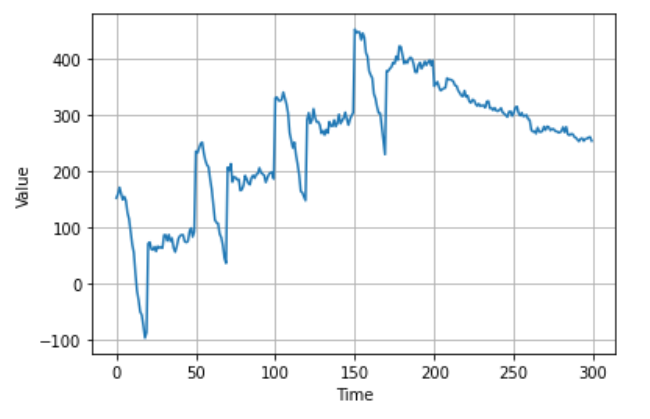
i. Impulses
# impulses
def impulses(time, num_impulses, amplitude=1, seed=None):
rnd = np.random.RandomState(seed)
impulse_indices = rnd.randint(len(time), size=10)
series = np.zeros(len(time))
for index in impulse_indices:
series[index] += rnd.rand() * amplitude
return series
series = impulses(time, 10, seed=42)
plot_series(time, series)

j. Autocorrelation and Impulses
# autocorrelation + impulses
def autocorrelation(source, φs):
ar = source.copy()
max_lag = len(φs)
for step, value in enumerate(source):
for lag, φ in φs.items():
if step - lag > 0:
ar[step] += φ * ar[step - lag]
return ar
signal = impulses(time, 10, seed=42)
series = autocorrelation(signal, {1: 0.99})
plot_series(time, series)
plt.plot(time, signal, "k-")
plt.show()S
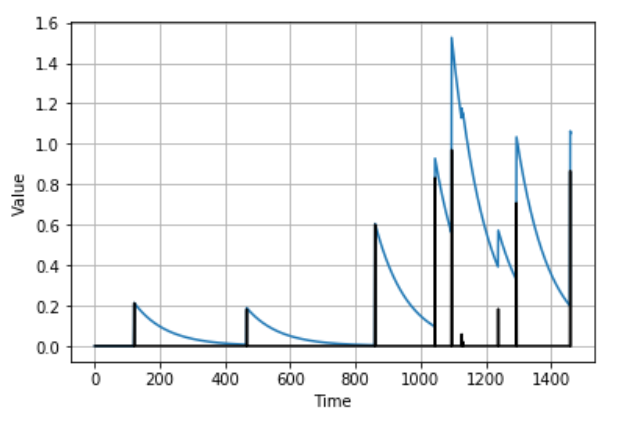
series_diff1 = series[1:] - series[:-1]
plot_series(time[1:], series_diff1)

2. DNN
# Data preparation
def window_dataset(series, window_size, batch_size, shuffle_buffer):
dataset = tf.data.Dataset.from_tensor_slices(series)
dataset = dataset.window(window_size + 1, shift=1, drop_remainder=True)
dataset = dataset.flat_map(lambda window : window.batch(window_size + 1))
dataset = dataset.shuffle(shuffle_buffer).map(lambda window : (window[:-1], window[-1]))
dataset = dataset.batch(batch_size).prefetch(1)
return dataset
# Forecast
forecast = []
for time in range(len(series) - window_size):
if time == 0:
print(series[time:time + window_size][np.newaxis])
forecast.append(model.predict(series[time:time + window_size][np.newaxis]))
forecast = forecast[split_time-window_size:]
print(forecast)
results = np.array(forecast)[:, 0, 0]
# Callbacks
model = tf.keras.models.Sequential([
tf.keras.layers.Dense(10, input_shape=[window_size], activation='relu'),
tf.keras.layers.Dense(10, activation='relu'),
tf.keras.layers.Dense(1)
])
lr_schedule = tf.keras.callbacks.LearningRateScheduler(
lambda epoch : 1e-8 * 10 ** (epoch / 20)
)
optimizer = tf.keras.optimizers.SGD(lr=1e-8, momentum=0.9)
model.compile(loss='mse', optimizer=optimizer)
history = model.fit(dataset, epochs=100, callbacks=[lr_schedule], verbose=0)
lrs = 1e-8 * 10 ** (np.arange(100) / 20)
plt.figure()
plt.semilogx(lrs, history.history['loss'])
plt.axis([1e-8, 1e-3, 0, 30])
plt.show()
3. RNN
# Simple RNN
tf.keras.backend.clear_session()
tf.random.set_seed(51)
np.random.seed(51)
model = tf.keras.models.Sequential([
tf.keras.layers.Lambda(lambda x : tf.expand_dims(x, axis=-1), input_shape=[None]),
tf.keras.layers.SimpleRNN(40, return_sequences=True),
tf.keras.layers.SimpleRNN(40),
tf.keras.layers.Dense(1),
tf.keras.layers.Lambda(lambda x : x * 100.0)
])
optimizer = tf.keras.optimizers.SGD(lr=5e-5, momentum=0.9)
model.compile(loss=tf.keras.losses.Huber(),
optimizer=optimizer,
metrics=['mae'])
history = model.fit(dataset, epochs=400)
# LSTM
model = tf.keras.models.Sequential([
tf.keras.layers.Lambda(lambda x : tf.expand_dims(x, axis=-1), input_shape=[None]),
tf.keras.layers.Bidirectional(tf.keras.layers.LSTM(32, return_sequences=True)),
tf.keras.layers.Bidirectional(tf.keras.layers.LSTM(32)),
tf.keras.layers.Dense(1),
tf.keras.layers.Lambda(lambda x : x * 100.0)
])
4. Sunspots
# data preparation
def windowed_dataset(series, window_size, batch_size, shuffle_buffer):
series = tf.expand_dims(series, axis=-1)
ds = tf.data.Dataset.from_tensor_slices(series)
ds = ds.window(window_size + 1, shift=1, drop_remainder=True)
ds = ds.flat_map(lambda w: w.batch(window_size + 1))
ds = ds.shuffle(shuffle_buffer)
ds = ds.map(lambda w: (w[:-1], w[1:]))
return ds.batch(batch_size).prefetch(1)
# forecast function
def model_forecast(model, series, window_size):
ds = tf.data.Dataset.from_tensor_slices(series)
ds = ds.window(window_size, shift=1, drop_remainder=True)
ds = ds.flat_map(lambda w: w.batch(window_size))
ds = ds.batch(32).prefetch(1)
forecast = model.predict(ds)
return forecast
# model
tf.keras.backend.clear_session()
tf.random.set_seed(51)
np.random.seed(51)
train_set = windowed_dataset(x_train, window_size=60, batch_size=100, shuffle_buffer=shuffle_buffer_size)
model = tf.keras.models.Sequential([
tf.keras.layers.Conv1D(filters=60, kernel_size=5,
strides=1, padding="causal",
activation="relu",
input_shape=[None, 1]),
tf.keras.layers.LSTM(60, return_sequences=True),
tf.keras.layers.LSTM(60, return_sequences=True),
tf.keras.layers.Dense(30, activation="relu"),
tf.keras.layers.Dense(10, activation="relu"),
tf.keras.layers.Dense(1),
tf.keras.layers.Lambda(lambda x: x * 400)
])
optimizer = tf.keras.optimizers.SGD(lr=1e-5, momentum=0.9)
model.compile(loss=tf.keras.losses.Huber(),
optimizer=optimizer,
metrics=["mae"])
history = model.fit(train_set,epochs=500)
# forecast
rnn_forecast = model_forecast(model, series[..., np.newaxis], window_size)
rnn_forecast = rnn_forecast[split_time - window_size:-1, -1, 0]